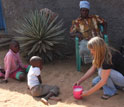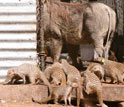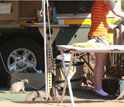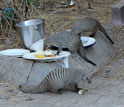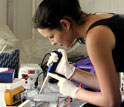News Release 13-084
Human Disease Leptospirosis Identified in New Species, the Banded Mongoose, in Africa
Scientists find widespread but neglected disease is significant health threat in Botswana
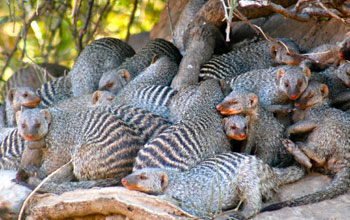
Banded mongoose troops are radio-collared and tracked across the landscape in Botswana.
May 14, 2013
This material is available primarily for archival purposes. Telephone numbers or other contact information may be out of date; please see current contact information at media contacts.
The newest public health threat in Africa, scientists have found, is coming from a previously unknown source: the banded mongoose.
Leptospirosis, the disease is called. And the banded mongoose carries it.
Leptospirosis is the world's most common illness transmitted to humans by animals. It's a two-phase disease that begins with flu-like symptoms. If untreated, it can cause meningitis, liver damage, pulmonary hemorrhage, renal failure and death.
"The problem in Botswana and much of Africa is that leptospirosis may remain unidentified in animal populations but contribute to human disease, possibly misdiagnosed as other diseases such as malaria," said disease ecologist Kathleen Alexander of Virginia Tech.
With a grant from the National Science Foundation's (NSF) Coupled Natural and Human Systems Program, Alexander and colleagues found that the banded mongoose in Botswana is infected with Leptospira interrogans, the pathogen that causes leptospirosis.
Coupled Natural and Human Systems is part of NSF's Science, Engineering and Education for Sustainability investment and is supported by NSF's Directorates for Biological Sciences; Geosciences; and Social, Behavioral and Economic Sciences.
"The transmission of infectious diseases from wildlife to humans represents a serious and growing public health risk due to increasing contact between humans and animals," said Alan Tessier, program director in NSF's Division of Environmental Biology. "This study identified an important new avenue for the spread of leptospirosis."
The results are published today in a paper in the journal Zoonoses and Public Health. The paper was co-authored by Alexander, Sarah Jobbins and Claire Sanderson of Virginia Tech.
The banded mongoose, although wild, lives in close proximity to humans, sharing scarce water resources and scavenging in human waste.
The disease-causing pathogen it carries can pass to humans through soil or water contaminated with infected urine.
Mongoose and other species are consumed as bushmeat, which may also contribute to leptospirosis exposure and infection in humans.
"I was convinced that we were going to find Leptospira interrogans in some species in the ecosystem," said Alexander.
"The pathogen had not been reported previously in Botswana, with the exception of one cow more than a quarter of a century ago.
"We looked at public health records dating back to 1974 and there were no records of any human cases of leptospirosis. Doctors said they were not expecting to see the disease in patients. They were not aware that the pathogen occurred in the country."
Alexander conducted a long-term study of human, wildlife and environmental health in the Chobe District of Northern Botswana, an area that includes the Chobe National Park, forest reserves and surrounding villages.
"This pathogen can infect many animals, both wild and domestic, including dogs," said Jobbins. "Banded mongoose is likely not the only species infected."
The researchers worked to understand how people, animals and the environment are connected, including the potential for diseases to move between humans and wildlife.
"Diseases such as leptospirosis that have been around for a very long time are often overlooked amid the hunt for the next newly emerging disease," Alexander said.
Leptospirosis was first described in 1886, said Jobbins, "but we still know little about its occurrence in Africa."
With the new identification of leptospirosis in Botswana, Alexander is concerned about the public health threat it may pose to the immunocompromised population there. Some 25 percent of 15- to 49-year-olds are HIV positive.
"In much of Africa, people die without a cause being determined," she said.
"Leptospirosis is likely affecting human populations in this region. But without knowledge that the organism is present in the environment, overburdened public health officials are unlikely to identify clinical cases in humans, particularly if the supporting diagnostics are not easily accessible."
The researchers looked for Leptospira interrogans in archived kidneys collected from banded mongoose that had been found dead from a variety of causes. Of the sampled mongoose, 43 percent tested positive for the pathogen.
"Given this high prevalence in the mongoose, we believe that Botswana possesses an as-yet-unidentified burden of human leptospirosis," said Jobbins.
"There is an urgent need to look for this disease in people who have clinical signs consistent with infection."
Because banded mongoose have an extended range across sub-Saharan Africa, the results have important implications for public health beyond Botswana.
"Investigating exposure in other wildlife, and assessing what species act as carriers, is essential for improving our understanding of human, wildlife, and domestic animal risk of leptospirosis in this ecosystem," the scientists write in their paper.
The paper also cites predictions that the region will become more arid, concentrating humans and animals around limited water supplies and increasing the potential for disease transmission.
"Infectious diseases, particularly those that can be transmitted from animals, often occur where people are more vulnerable to environmental change and have less access to public health services," said Alexander.
"That's particularly true in Africa. While we're concerned about emerging diseases that might threaten public health--the next new pandemic--we need to be careful that we don't drop the ball and stop pursuing important diseases like leptospirosis."
Alexander is working to identify immediate research and management actions--in particular, alerting frontline medical practitioners and public health officials to the potential for leptospirosis in humans.
The research was also funded by the WildiZe Foundation. Jobbins and Sanderson were supported in part by Virginia Tech's Fralin Life Science Institute.
-NSF-
-
Scientist Kathleen Alexander studies disease transmission in villages in Botswana.
Credit and Larger Version -
Mongoose, along with other species such as warthogs, are experts at finding human trash.
Credit and Larger Version -
Residents aren't the only people to meet up with a banded mongoose; tourists do too.
Credit and Larger Version -
Banded mongoose share the Botswana landscape with humans; leptospirosis often follows.
Credit and Larger Version -
Researcher Sarah Jobbins works in a field laboratory in Botswana, testing for leptospirosis.
Credit and Larger Version
Media Contacts
Cheryl Dybas, NSF, (703) 292-7734, email: cdybas@nsf.gov
Lynn Davis, Virginia Tech, (540) 231-6157, email: davisl@vt.edu
Related Websites
NSF Science, Engineering and Education for Sustainability Investment: http://www.nsf.gov/sees
NSF Publication: Discoveries in Sustainability: http://www.nsf.gov/pubs/2012/disco12001/disco12001.pdf
Conservation of African Resources, Animals, Communities And Land Use: http://www.caracal.info
The U.S. National Science Foundation propels the nation forward by advancing fundamental research in all fields of science and engineering. NSF supports research and people by providing facilities, instruments and funding to support their ingenuity and sustain the U.S. as a global leader in research and innovation. With a fiscal year 2023 budget of $9.5 billion, NSF funds reach all 50 states through grants to nearly 2,000 colleges, universities and institutions. Each year, NSF receives more than 40,000 competitive proposals and makes about 11,000 new awards. Those awards include support for cooperative research with industry, Arctic and Antarctic research and operations, and U.S. participation in international scientific efforts.
Connect with us online
NSF website: nsf.gov
NSF News: nsf.gov/news
For News Media: nsf.gov/news/newsroom
Statistics: nsf.gov/statistics/
Awards database: nsf.gov/awardsearch/
Follow us on social
Twitter: twitter.com/NSF
Facebook: facebook.com/US.NSF
Instagram: instagram.com/nsfgov



